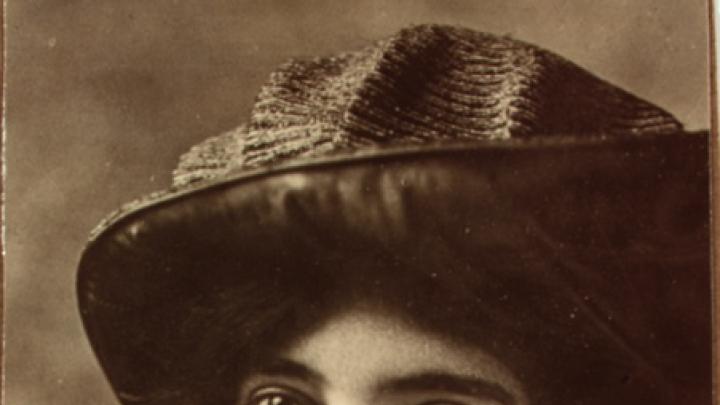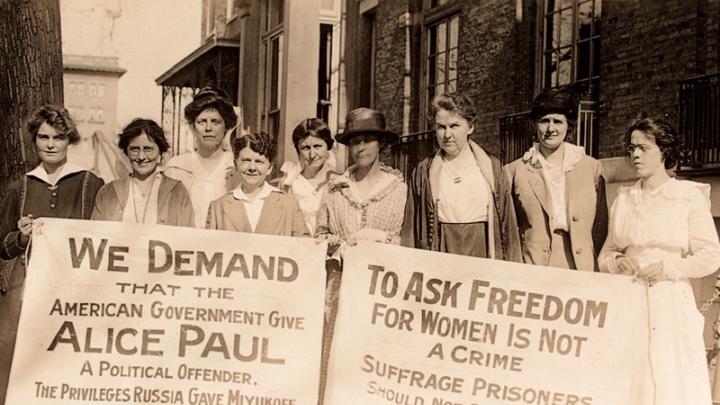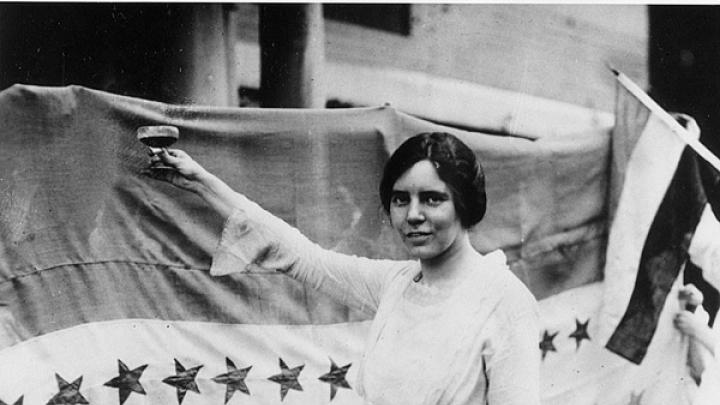When on January 10, 1917, Alice Paul challenged Woodrow Wilson to a political face-off, she was a day shy of 32, a slightly built New Jersey Quaker with a crown of dark hair and compelling violet-blue eyes--“great earnest childlike eyes that seem to seize you and hold you to her purpose,” wrote a supporter. “Suffragists Carry Fight to Gates of White House,” clamored the headlines.
Picketing the White House, a first in the annals of protest, capped a four-year campaign for a federal women’s suffrage amendment that had made Paul the country’s most controversial suffrage leader. But neither the parades she organized, nor the lobbying, demonstrations, publicity stunts, meetings, petitions, or electoral campaigns had won over hostile southern Democrats in Congress.
Wilson, she strategized, held the key. Though a progressive Democrat, the Virginia-born president was no friend of suffrage. Publicly he maintained that states should decide their own course. (Only 11 thinly populated western states, plus the territory of Alaska, had awarded women full voting privileges.) Privately, he told a correspondent, “my personal judgment is strongly against it.”
Paul set out to shame the president into changing, if not his mind, at least his position, and that of his legislative kinsmen.
Little in her cloistered background hinted at the charismatic and clever tactician she had become. Born on a small farm in Mt. Laurel, New Jersey, the eldest of four, the young Alice “never met anybody who wasn’t a Quaker,” apart from her family’s Irish Catholic maids. Quakers believe in dedication to a divinely inspired “concern.” For an earlier generation it was abolition. For Paul, it was suffrage. She graduated from Swarthmore in 1905, flirted with social work on New York’s Lower East Side, and traveled to England in 1907 for further studies. There she enlisted in the militant wing of the British suffrage movement headed by Emmeline Pankhurst. Paul dreaded public speaking, but was fearless of confrontation. She returned to the United States in 1910, a veteran of imprisonments, hunger strikes, and an ugly episode of force-feeding.
She had launched her American campaign in 1913, under the auspices of the National American Woman Suffrage Association, with a massive suffrage parade on Pennsylvania Avenue the day before Wilson’s inauguration. Now, she and her followers were at his doorstep. They called themselves “Silent Sentinels” but they carried banners that shrieked. “Mr. President, how long must women wait for liberty?” “Mr. President, what will you do for woman suffrage?” They mined Wilson’s statements for hypocrisy. When in April 1917 he declared, in his war message to Congress, “We shall fight…for democracy, for the right of those who submit to authority to have a voice in their own governments,” the same words were held aloft days later by women with no voice in their government.
Hecklers, inflamed by war fever, branded the demonstrating women “Traitors!” and ripped down their signs. Tensions escalated in June when a new banner accused Wilson of lying to Russia when he claimed America was a democracy. The next day, the suffragists on duty--wives and mothers, young college graduates, social luminaries and progressive “new women”--were hurled to the ground, their banners torn away and shredded. Then they were arrested--and charged with “obstructing traffic.”
The first sentences were for three days. The picketing, and arrests, continued. When sentences for repeat offenders reached 60 days, Wilson issued an unconditional pardon. Suffragists resumed their vigil. “Kaiser Wilson” trumpeted a sign. Wilson lost patience.
On October 6, Paul was arrested while picketing and eventually confined to a prison psychiatric ward. Her windows were boarded shut, a light beamed into her eyes hourly. A psychiatrist pressed her to admit that she had a fixation on Wilson. When the prison doctor threatened her, she felt fear of another human being for the first time in her life. She refused food; she was force-fed.
Before her imprisonment, she called for a massive picket line to overwhelm the penal system. And on November 14, 31 suffragists arrived at a Maryland workhouse. The press, bowing to White House pressure, buried news of the protestors, but reports of brutal treatment leaked out. Late in November, all the prisoners were released after a trial that turned on a technicality.
A year after the picketing began, Wilson announced his support for the amendment “as an act of right and justice to the women of the country and the world.” Backtracking from his states-rights position, he declared suffrage a “national question.” America’s allies, grateful for women’s war service, were giving women the vote, he noted. The United States should do no less.
When the Nineteenth Amendment became law on August 26, 1920, Paul had won more than the vote. A federal court had thrown out charges against the pickets, and permits to demonstrate in the nation’s capital, once denied, were now grudgingly issued. The legal precedents set by her efforts empowered future protestors, with her pioneering campaign of civil disobedience as a model.
Post suffrage, Paul armed herself with three law degrees for battles ahead. She wrote and campaigned for the Equal Rights Amendment, living to see it pass, but dying too soon to know it would never be ratified. Once women achieved freedom, she said late in life, “they probably are going to do a lot of things that I wish they wouldn’t do; but it seems to me that it isn’t our business, to say what they should do with it. It is our business to see that they are free.”











